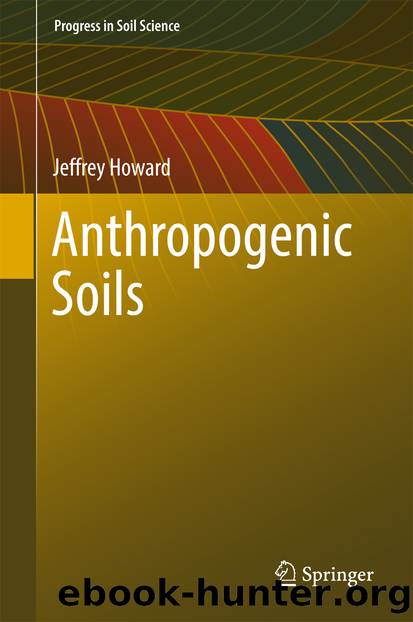Anthropogenic Soils by Jeffrey Howard

Author:Jeffrey Howard
Language: eng
Format: epub
Publisher: Springer International Publishing, Cham
7.2 Types of Anthrosols
Anthropogenic soils in agricultural settings comprise the Anthrosol Reference Soil Group in the World Reference Base (IUSS Working Group 2015). Anthrosols are found wherever people have practiced agriculture for generations, often for many centuries or even millennia. Most of these soils are not addressed in U.S. Soil Taxonomy because they are not known to exist in the United States, or are of very limited extent. Hence, the terminology of the WRB is followed here.
There are six basic types of Anthrosol: (1) Hortic, (2) Plaggic, (3) Terric, (4) Pretic, (5) Irragric, and (6) Hydragric (Table 7.1). All are natural soils that have been strongly altered by human activity, usually by forming a new, overthickened A horizon, which rests on subsoil remnants of the original profile. Hortic, Plaggic and Pretic Anthrosols are comprised of a thick, black (10YR2/1), organic-rich topsoil characterized by elevated levels of phosphorous, and which commonly contains artifacts of archaeological significance. Hortic and Pretic Anthrosols show a high degree of biological activity, both in terms of macrofauna and microfauna. Plaggic, Terric and Irragric Anthrosols are all found on raised land surfaces, but Plaggic and Terric Anthrosols are on surfaces which have been raised directly by human additions of solid earth materials, whereas Irragric Anthrosols are on ground surfaces which have been raised indirectly as a result of irrigation. Hortic, Plaggic and Pretic Anthrosols often contain abundant charcoal fragments, but Pretic Anthrosols are distinguished by the presence of biochar. Hydragric Anthrosols are characterized by redoximorphic features produced by prolonged submergence beneath water ponded for rice farming, typically in an excessively wet climatic setting. In contrast, Irragric Anthrosols are found in dry climate regions, and have unique pedogenic features associated with excess soluble salts. Anthrosols are formed in human-altered material, as defined in U.S. Soil Taxonomy, except for Plaggic and Terric Anthrosols which are formed in human-transported material.Table 7.1Classification and characteristics of Anthrosols found in agricultural settings
Download
This site does not store any files on its server. We only index and link to content provided by other sites. Please contact the content providers to delete copyright contents if any and email us, we'll remove relevant links or contents immediately.
| Automotive | Engineering |
| Transportation |
Whiskies Galore by Ian Buxton(40326)
Introduction to Aircraft Design (Cambridge Aerospace Series) by John P. Fielding(32337)
Small Unmanned Fixed-wing Aircraft Design by Andrew J. Keane Andras Sobester James P. Scanlan & András Sóbester & James P. Scanlan(32141)
Craft Beer for the Homebrewer by Michael Agnew(17445)
Turbulence by E. J. Noyes(7037)
The Complete Stick Figure Physics Tutorials by Allen Sarah(6637)
Kaplan MCAT General Chemistry Review by Kaplan(6053)
The Thirst by Nesbo Jo(5783)
Bad Blood by John Carreyrou(5766)
Learning SQL by Alan Beaulieu(5407)
Weapons of Math Destruction by Cathy O'Neil(5034)
Man-made Catastrophes and Risk Information Concealment by Dmitry Chernov & Didier Sornette(4734)
iGen by Jean M. Twenge(4702)
Digital Minimalism by Cal Newport;(4529)
Life 3.0: Being Human in the Age of Artificial Intelligence by Tegmark Max(4501)
Audition by Ryu Murakami(4097)
1,001 ASVAB Practice Questions For Dummies by Powers Rod(4036)
Electronic Devices & Circuits by Jacob Millman & Christos C. Halkias(4024)
Pale Blue Dot by Carl Sagan(4001)
